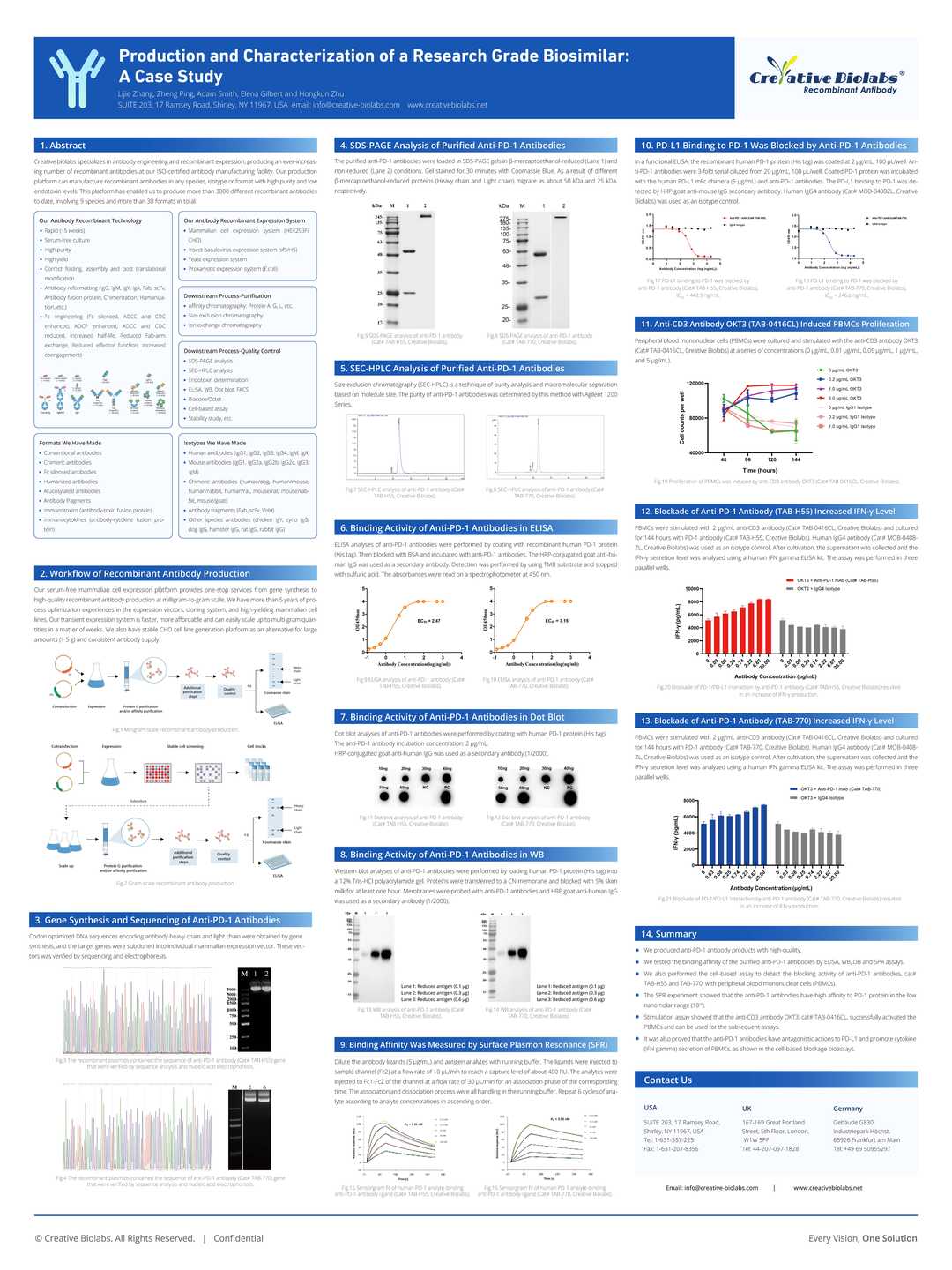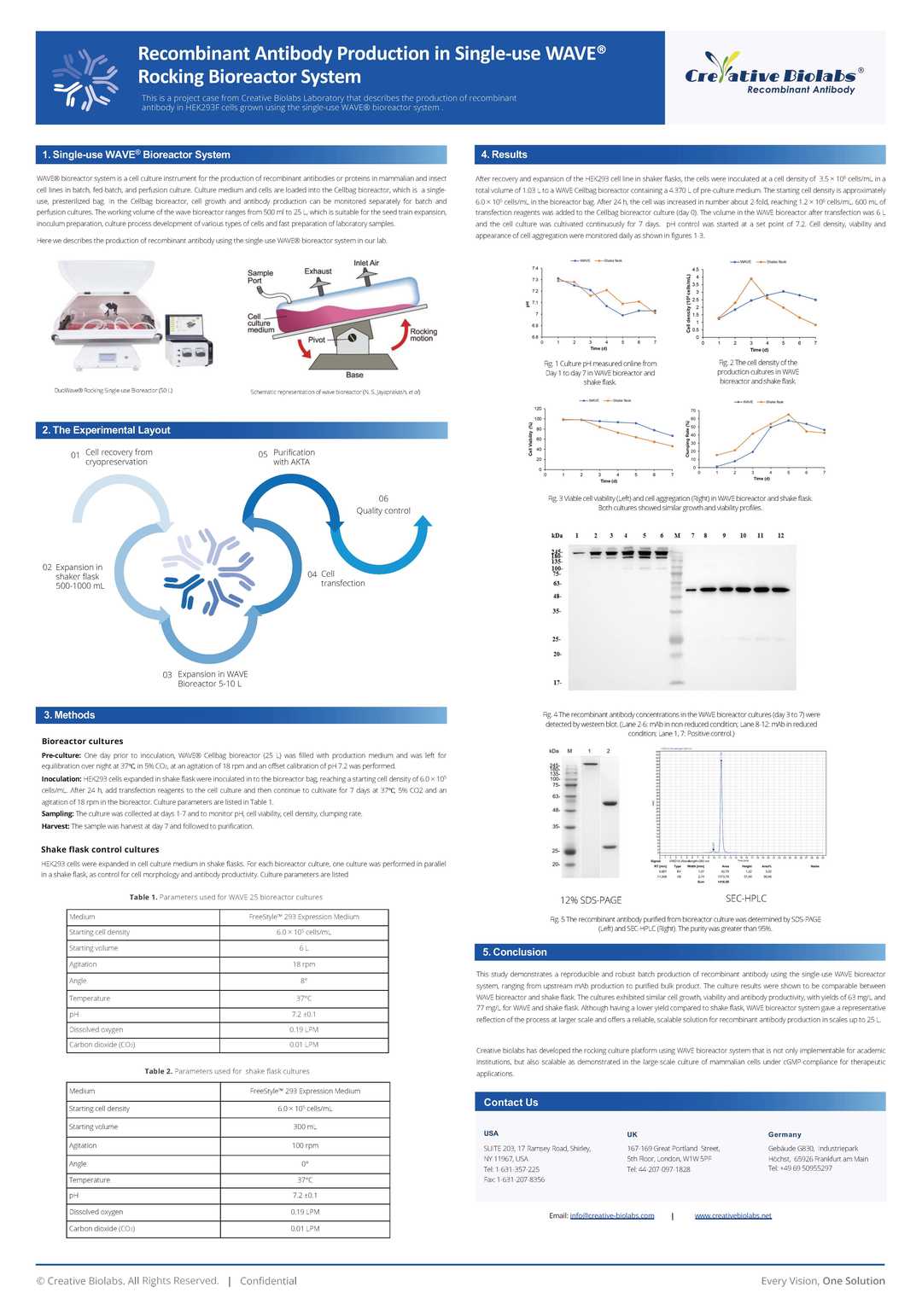Anti-Human EGFL7 Recombinant Antibody (TAB-902)
CAT#: TAB-902
Recombinant humanized (from mouse) antibody expressed in CHO binding to human EGFL7. It is a humanized monoclonal antibody designed for the treatment of cancer. It acts as an immunomodulator and binds to EGFL7.







Specifications
- Immunogen
- The details of the immunogen for this antibody are not available.
- Host Species
- Mouse
- Derivation
- Humanized (from mouse)
- Type
- IgG1 - kappa
- Species Reactivity
- Human
- Applications
- Block
- MW
- 147.8 kDa
- Related Disease
- Solid tumors
Product Property
- Purity
- >95.0% as determined by Analysis by RP-HPLC & analysis by SDS-PAGE.
- Storage
- Store at +4°C short term (1-2 weeks). Aliquot and store at -20°C long term. Avoid repeated freeze/thaw cycles.
Applications
- Application Notes
- The Human EGFL7 antibody has been reported in applications of Blocking.
Block: 100 μg/ml.
Target
Customer Review
There are currently no Customer reviews or questions for TAB-902. Click the button above to contact us or submit your feedback about this product.
 Laura Scott
Laura Scott18.Oct,23
 David Young
David Young05.Dec,22
 Megan Martinez
Megan Martinez09.Jul,21
Q&As
-
Is the anti-Human EGFL7 antibody suitable for use in Western blotting?
A: Yes, the anti-Human EGFL7 antibody (TAB-902) is suitable for use in Western blotting. It provides specific binding to EGFL7, allowing for reliable detection in Western blot assays.
-
What are the storage recommendations for the anti-Human EGFL7 antibody ?
A: The recommended storage condition for the anti-Human EGFL7 antibody (TAB-902) is at -20°C or lower. For short-term storage, it can be kept at 2-8°C. To ensure stability, avoid repeated freeze-thaw cycles.
-
Can the anti-Human EGFL7 antibody be used in immunoprecipitation assays?
A: Yes, the anti-Human EGFL7 antibody (TAB-902) can be used in immunoprecipitation assays. It provides specific binding to EGFL7, enabling the successful precipitation of the target protein from complex mixtures.
-
Is the anti-Human EGFL7 antibody effective in ELISA applications?
A: Yes, the anti-Human EGFL7 antibody (TAB-902) is effective in ELISA applications. It has been validated for use in such assays and provides reliable detection of EGFL7.
-
What is the optimal dilution for using the anti-Human EGFL7 antibody in immunofluorescence?
A: The optimal dilution for using the anti-Human EGFL7 antibody (TAB-902) in immunofluorescence is typically 1:100 to 1:500. It is advisable to perform a dilution series to determine the best working concentration for your specific experimental conditions.
View the frequently asked questions answered by Creative Biolabs Support.
Citations
-
Bill, Marius, et al. "EGFL7 antagonizes NOTCH signaling and represents a novel therapeutic target in acute myeloid leukemia." Clinical Cancer Research 26.3 (2020): 669-678. https://doi.org/10.1158/1078-0432.CCR-19-2479This study investigated the role of EGF-like domain 7 (EGFL7) in acute myeloid leukemia (AML) and its potential as a therapeutic target. The researchers found that EGFL7 is upregulated in AML and contributes to leukemogenesis by antagonizing NOTCH signaling. Through various in vitro and in vivo experiments, the study demonstrated that blocking EGFL7 with an anti-EGFL7 antibody (parsatuzumab) reactivated NOTCH signaling, leading to increased differentiation and apoptosis of leukemic cells. Additionally, anti-EGFL7 treatment prolonged the survival of AML mouse models, indicating the potential of EGFL7 as a novel therapeutic target for AML.
Creative Biolabs provided the anti-EGFL7 therapeutic antibody, parsatuzumab (Cat#: TAB-902), which was critical for the experiments that demonstrated the reactivation of NOTCH signaling and the resulting differentiation and apoptosis of AML cells. The use of parsatuzumab allowed the researchers to validate the therapeutic potential of targeting EGFL7 in AML and provided significant insights into the molecular mechanisms by which EGFL7 influences leukemogenesis. This contribution was essential for establishing EGFL7 as a viable target for AML treatment. -
Papaioannou, Dimitrios, et al. "Prognostic and biological significance of the proangiogenic factor EGFL7 in acute myeloid leukemia." Proceedings of the National Academy of Sciences 114.23 (2017): E4641-E4647. https://doi.org/10.1073/pnas.1703142114This research investigates the prognostic and biological significance of Epithelial Growth Factor-Like 7 (EGFL7) in acute myeloid leukemia (AML). The study demonstrates that EGFL7 mRNA and protein expression levels are significantly increased in AML blasts compared to normal bone marrow cells. High EGFL7 expression was associated with lower complete remission rates and shorter event-free and overall survival in both younger and older patients with cytogenetically normal AML. Importantly, the research reveals that AML blasts secrete EGFL7 protein, with higher levels detected in sera from AML patients compared to healthy controls. Treatment of AML blasts with recombinant EGFL7 in vitro resulted in increased leukemic blast cell growth and phosphorylated AKT levels, while EGFL7 blockade with an anti-EGFL7 antibody reduced growth potential and viability of AML cells.
Creative Biolabs provided humanized murine monoclonal antibody that binds to the EGFL7 protein and inhibits its function (parsatuzumab) for the study. The antibody would be crucial for the experiments demonstrating EGFL7's role in AML blast proliferation and for the therapeutic blockade studies. The availability of high-quality, validated reagents targeting EGFL7 would enable researchers to effectively investigate the autocrine mechanism by which EGFL7 supports leukemic blast growth and evaluate the potential of EGFL7-targeted therapy in AML treatment.
Cite This Product
To accurately reference this product in your publication, please use the following citation information:
(Creative Biolabs Cat# TAB-902, RRID: AB_3112018)
Submit Your Publication
Published with our product? Submit your paper and receive a 10% discount on your next order! Share your research to earn exclusive rewards.
Publications
Peer-reviewed PublicationsOur products have been used extensively by scientists all over the world to accelerate their life science research. Here, we present a collection of publications that cite this product.
Biosimilar Overview
Please refer to Parsatuzumab Overview to learn more about the mechanism of action, clinical projects, and approved drugs of Parsatuzumab.
Downloadable Resources
Download resources about recombinant antibody development and antibody engineering to boost your research.
Product Notes
This is a product of Creative Biolabs' Hi-Affi™ recombinant antibody portfolio, which has several benefits including:
• Increased sensitivity
• Confirmed specificity
• High repeatability
• Excellent batch-to-batch consistency
• Sustainable supply
• Animal-free production
See more details about Hi-Affi™ recombinant antibody benefits.
Datasheet
MSDS
COA
Certificate of Analysis LookupTo download a Certificate of Analysis, please enter a lot number in the search box below. Note: Certificate of Analysis not available for kit components.
See other products for "EGFL7"
Select a product category from the dropdown menu below to view related products.
| CAT | Product Name | Application | Type |
|---|---|---|---|
| NAB-834-VHH | Recombinant Anti-Human EGFL7 VHH Single Domain Antibody | IHC, ICC, FC, FA, FUNC | Llama VHH |
| CAT | Product Name | Application | Type |
|---|---|---|---|
| MOB-2365MZ | Recombinant Mouse Anti-Human EGFL7 Antibody | WB | Mouse antibody |
| HPAB-0001-DJB | Mouse Anti-EGFL7 Recombinant Antibody (HPAB-0001-DJB) | ELISA, WB | Mouse IgG2b |
| HPAB-0002-DJB | Mouse Anti-EGFL7 Recombinant Antibody (HPAB-0002-DJB) | ELISA, WB | Mouse IgG2b |
| HPAB-0003-DJB | Mouse Anti-EGFL7 Recombinant Antibody (HPAB-0003-DJB) | ELISA, WB | Mouse IgG2b |
| HPAB-0951WJ | Mouse Anti-EGFL7 Recombinant Antibody (clone 4F11.v1) | ELISA | Mouse IgG |
| CAT | Product Name | Application | Type |
|---|---|---|---|
| HPAB-0001-DJB-S(P) | Mouse Anti-EGFL7 Recombinant Antibody scFv Fragment (HPAB-0001-DJB-S(P)) | ELISA, WB | Mouse scFv |
| HPAB-0002-DJB-S(P) | Mouse Anti-EGFL7 Recombinant Antibody scFv Fragment (HPAB-0002-DJB-S(P)) | ELISA, WB | Mouse scFv |
| HPAB-0003-DJB-S(P) | Mouse Anti-EGFL7 Recombinant Antibody; scFv Fragment (HPAB-0003-DJB-S(P)) | ELISA, WB | Mouse scFv |
| HPAB-0951WJ-S(P) | Mouse Anti-EGFL7 Recombinant Antibody (clone 4F11.v1); scFv Fragment | ELISA | Mouse scFv |
| HPAB-0952WJ-S(P) | Mouse Anti-EGFL7 Recombinant Antibody (clone 4F11.v17); scFv Fragment | ELISA | Mouse scFv |
| CAT | Product Name | Application | Type |
|---|---|---|---|
| HPAB-0001-DJB-F(E) | Mouse Anti-EGFL7 Recombinant Antibody Fab Fragment (HPAB-0001-DJB-F(E)) | ELISA, WB | Mouse Fab |
| HPAB-0002-DJB-F(E) | Mouse Anti-EGFL7 Recombinant Antibody Fab Fragment (HPAB-0002-DJB-F(E)) | ELISA, WB | Mouse Fab |
| HPAB-0003-DJB-F(E) | Mouse Anti-EGFL7 Recombinant Antibody; Fab Fragment (HPAB-0003-DJB-F(E)) | ELISA, WB | Mouse Fab |
| HPAB-0951WJ-F(E) | Mouse Anti-EGFL7 Recombinant Antibody (clone 4F11.v1); Fab Fragment | ELISA | Mouse Fab |
| HPAB-0952WJ-F(E) | Mouse Anti-EGFL7 Recombinant Antibody (clone 4F11.v17); Fab Fragment | ELISA | Mouse Fab |
| CAT | Product Name | Application | Type |
|---|---|---|---|
| AFC-TAB-902 | Afuco™ Anti-EGFL7 ADCC Recombinant Antibody, ADCC Enhanced (AFC-TAB-902) | ELISA, IP, FC, FuncS, Neut | ADCC enhanced antibody |
| CAT | Product Name | Application | Type |
|---|---|---|---|
| VS-0425-FY102 | Mouse Anti-EGFL7 (clone 18F7.v6) scFv-Fc Chimera | Inhib | Mouse IgG1, scFv-Fc |
| CAT | Product Name | Application | Type |
|---|---|---|---|
| VS-0525-YC63 | Recombinant Anti-EGFL7 (AA 66-69 x AA 88-90) Biparatopic Antibody, Tandem scFv | ELISA, WB | Tandem scFv |
| CAT | Product Name | Application | Type |
|---|---|---|---|
| VS-0625-YC98 | Recombinant Anti-EGFL7 Eliminating Antibody, pH-Sensitive (VS-0625-YC98) | Antigen-Sweeping In Vivo. | Mouse IgG1 kappa |
| CAT | Product Name | Application | Type |
|---|---|---|---|
| VS-0825-YC109 | SmartAb™ Recombinant Anti-EGFL7 pH-dependent Antibody (VS-0825-YC109) | ELISA, WB | Mouse IgG2b |
Popular Products

Application: FC, IP, ELISA, Neut, FuncS, IF, IHC

Application: FuncS, IF, Neut, ELISA, FC, IP, IHC

Application: WB, FC, IP, ELISA, Neut, FuncS, IF
-2.png)
Application: ELISA, FC, IP, FuncS, IF, Neut, ICC

Application: ELISA, FC, IP, FuncS, IF, Neut, ICC

Application: WB, ELISA, Neut, FuncS

Application: Block, IP, IF, FC

Application: ELISA, IHC, FC, IP, IF, FuncS

Application: FC

Application: ELISA, IHC, WB

Application: ELISA, Block, WB, FC, IP

Application: EM, ELISA, ICC, IHC-Fr, IHC-P, WB
For research use only. Not intended for any clinical use. No products from Creative Biolabs may be resold, modified for resale or used to manufacture commercial products without prior written approval from Creative Biolabs.
This site is protected by reCAPTCHA and the Google Privacy Policy and Terms of Service apply.




















